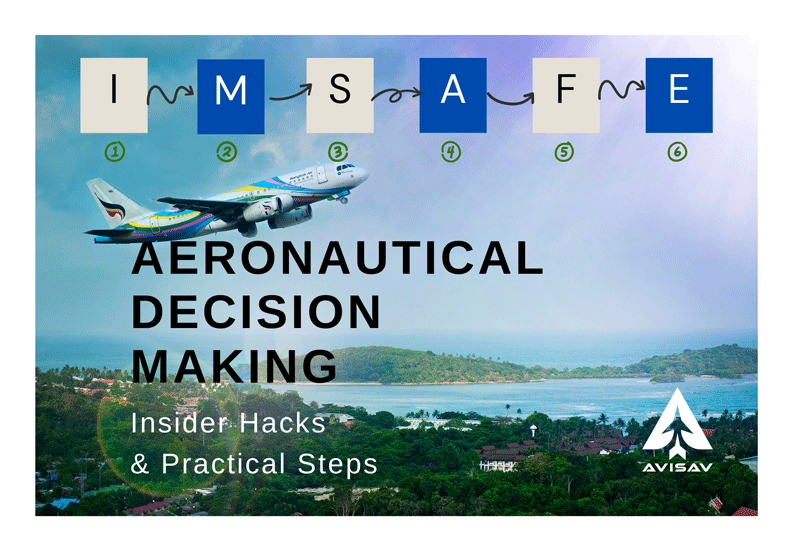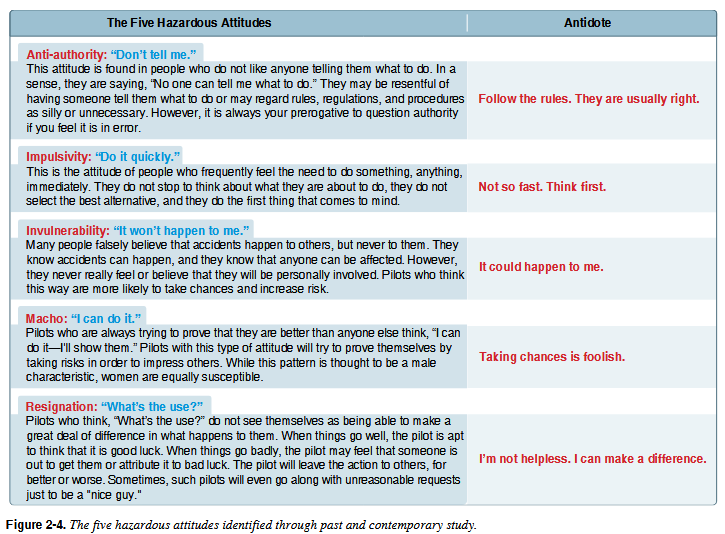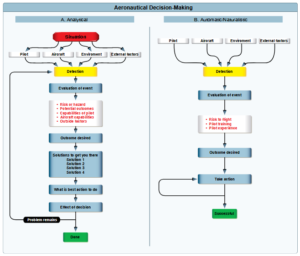
Introduction.
Aeronautical Decision Making (ADM) is the process by which aviation personnel makes decisions in order to deal with the complex situations they encounter in an effective manner. Aeronautical decision making is a method of the mental process used by pilots in order to continually decide on the best course of action to take in a given set of circumstances. ADM is a practical approach to mitigating risks, which is a crucial pillar (component) of the Safety Management System (SMS).
ADM focuses on the factors influencing the ability of the pilot to make effective choices. Understanding the Aeronautical Decision Making process provides a pilot with the basis for building skills for safe and efficient ADM.
Aeronautical Decision Making Six-Steps
The Pilot’s Aeronautical Decision Making Process is a powerful, six-step administrative skill a pilot must perform in order to maximize the chances for success in coping with unexpected or critical events. These steps are:
-
Identifying personal attitudes hazardous to safe flight:

Aeronautical Decision-Making The Five Hazardous Attitudes. Source FAA: https://www.faa.gov/regulations_policies/handbooks_manuals/aviation/phak/media/04_phak_ch2.pdf
Pilots need to be in a good physical and mental condition to fly safely. This includes having the right attitude, as this can affect the quality of decisions made while flying. There are five hazardous attitudes that can interfere with making sound decisions and exercising authority properly. These five hazardous attitudes are anti-authority, impulsivity, invulnerability, macho, and resignation.
-
Learning behavior modification techniques
Pilots can effectively counter the five hazardous attitudes by redirecting the hazardous attitude so that they can take corrective actions.
The first step in eliminating dangerous thoughts is recognizing them. After recognizing a thought as hazardous, the pilot should label it as such and then state the corresponding antidote. It’s better to memorize antidotes for each of the hazardous attitudes, so they automatically come to mind when needed.
-
Learning how to recognize and cope with stress
Stress typically impedes a pilot’s decision-making, leading to unsafe situations. Pilot error causes 50% to 90% of airline crashes.
A pilot’s risk of making a mistake on the flight deck can rise as a result of stressors. Stopping, reflecting, and analyzing before making a decision is essential for stress management. Before making rash judgments, there is usually time to think them over.
There are several ways to deal with the accumulation of life’s stresses and strains:
- Addressing the physical causes of stress. For example, making sure you get enough sleep, eat well, and exercise. Some of the most prominent sources of stress include hunger and fatigue, both of which have well-known effects.
- Swimming helps the nervous system get back into balance, and climbing stairs is a great way to get rid of extra toxins in the body. Usually, during layovers, both of these activities can be done in hotels, removing any lingering effects of stress before the subsequent flight.
- Constant Professional Development. Training guarantees proficiency and up-to-date knowledge of all routine and emergency operating procedures.
- Social Interaction. It’s not a good idea to let personal issues and concerns fester. It’s crucial to communicate your issues and concerns. Doing so offers some relief because other people might be able to provide support and guidance.
- Workload. Refrain from accepting too many obligations, both professional and personal, that could lead to work overload. When asked to complete too many tasks, it’s crucial to learn how to say “no.”
-
Developing risk assessment skills for Effective Aeronautical Decision Making

Aeronautical Decision-Making – WorkFlow. SourceFAA: https://www.faa.gov/regulations_policies/handbooks_manuals/aviation/phak/media/04_phak_ch2.pdf
The term “risk management,” is the process of identifying hazards and deciding what action to take to control and minimize those risks to a level considered acceptable by a regulatory agency. Click here to learn more about the Flight Risk Assessment Tool in AVISAV QSMS Software. AVISAV QSMS – FRAT Tool is specially designed to make risk assessment easier and more efficient.
As a pilot, you have to develop a sense of many of the possible risks. That may lead to poor decisions or outcomes while on an airplane. Because each flight has a certain degree of risk. It is crucial for pilots to be able to distinguish, ahead of time, a flight with a lower level of risk from one with a higher one then set up an inspection process and establish a strategy for mitigating risk. For example, by applying IMSAFE checklist. Also, by being mindful of the 5 dangerous attitudes that should be avoided. Pilots can make the first pass toward making the best choice during every Aeronautical Decision Making situation.
-
Using all resources
The pilot needs to work through the gathered information. Evaluate the effect it has on the safety of the flight, and decide the best course of action.
Resource Use: To make sound decisions in flight operations, a pilot should be mindful of resources found in the cockpit as well as those found outside it. To exercise responsibility effectively and make efficient decisions regarding flight outcomes, the pilot should become aware of human limitations.
-
Evaluating the effectiveness of one’s Aeronautical Decision Making skills
Excellent control of an aircraft and knowledge of it would be of little use if another engine failed following the poor decision by a pilot to divert to a non-flying airfield.
Do not continue under conditions outside of your capabilities. Nor with a lack of information that would have allowed for good decisions about this flight (such as an inadequate weather briefing).
Work on establishing a healthy mindset for reasonable decision-making. This will assist your decision-making process as well as execute optimal decisions within the aircraft’s operational limitations.
Finally, this model allows a pilot to enhance his/her aviation decision-making skills by applying a framework to each given situation. This cycle-based model allows a pilot to make a critical decision, then execute the sequence of events in order to achieve the best resolution.
To learn more about Safety Management System (SMS) practical steps, check out our Safety section. Also, check out our Safety Management Software and how it can enhance your organization’s safety performance.
